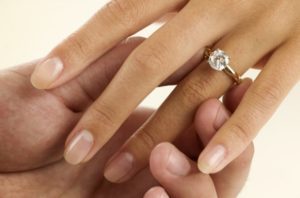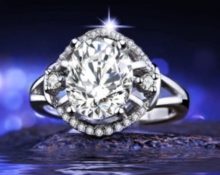A ring is not an easy piece of jewelry, even if we are not talking about an engagement ring! It should sit comfortably on the finger, be worn in the right place and at the right time, and be made of a suitable material. How not to make a mistake in choosing, read on.
Rules for choosing a ring
The choice of ring depends on:
- the reason for wearing it (or giving it);
- product size;
- age, status, appearance of its owner or owner.
 The ring can be worn not only on the “traditional” ring and middle fingers - modern fashion allows you to use any finger of the hand. When choosing jewelry for your thumb, consider: in size it can be almost the same as the average one, but the phalanx will still be wider, and, sitting loosely on the finger, the ring can be difficult to put on and take off.
The ring can be worn not only on the “traditional” ring and middle fingers - modern fashion allows you to use any finger of the hand. When choosing jewelry for your thumb, consider: in size it can be almost the same as the average one, but the phalanx will still be wider, and, sitting loosely on the finger, the ring can be difficult to put on and take off.
From time immemorial, a wide and massive decoration (ring) was put on the index finger or finger, which, however, should not interfere with the phalanges bending.
Important! Often the sizes of the middle and index fingers are the same. If this is the case for you, you can decorate both fingers alternately with the selected rings.The only exception is wedding options.
The most difficult thing to dress up is the little finger - it participates less than the others in gestures and manipulations of the hand, and therefore there is the least control over it. The risk of losing the ring you put on it is high, so you need tightly fitting products with a streamlined shape.
Ring selection criteria
To prevent an expensive purchase from gathering dust in a forgotten box, you should pay close attention to all the nuances associated with this decoration.
We are guided by the shape of the fingers
A very important criterion is that what decorates one brush will disfigure another!
 Those with “musical” hands with long and thin fingers have the most opportunities - products of any shape and size will look good on them. The only exceptions can be jewelry of an overly elongated shape, like case rings, hiding the finger from the very base to the top.
Those with “musical” hands with long and thin fingers have the most opportunities - products of any shape and size will look good on them. The only exceptions can be jewelry of an overly elongated shape, like case rings, hiding the finger from the very base to the top.- On chubby fingers, anything that will visually lengthen them is good - any triangles, rhombuses, rectangles, very elongated ovals. Large round stones, as well as thin products with an abundance of miniature elements, are taboo! Fashionable phalangeal rings will not work either.
- Narrow-shaped fingers look advantageous in all medium-sized options without stones. You can’t refuse the latter if you choose original shapes and complex compositions, but not single large stones of different shapes.
- There are many opportunities for those whose wide palms are decorated with large, long fingers. It is for them that massive oval diamonds and emeralds, rubies and sapphires (well, or something similar to them!) were created. Tiny rings are out of place here.
- Large stones - teardrop-shaped or oval - are also good for short fingers. Products with vertical decor are also suitable.Having decided to do without stones, choose all non-standard shapes - asymmetrical, angular, ribbed.
- Only convex shapes are prohibited - blown rings will add volume to your hand. And, of course, all the horizontal elements that visually expand the brush!
- Knobby fingers are well camouflaged with bright stones and flashy decor on wide and voluminous products. Thin products are not for this case.
Advice! The classic oval shape of nails and glossy varnish in “nude” shades will help correctly selected rings to visually lengthen your hand.
How to determine size?
 If you miss the size, you risk either losing the ring or suffering from tightness, and it is not possible to adjust the product in the workshop in all cases, and this can only be done by half a size without compromising the appearance of the jewelry.
If you miss the size, you risk either losing the ring or suffering from tightness, and it is not possible to adjust the product in the workshop in all cases, and this can only be done by half a size without compromising the appearance of the jewelry.
To measure fingers, a jewelry store has a ring gauge. When using it, you just need to take into account the following points:
- on the active hand all volumes are slightly larger;
- time of day and weather can change sizes;
- rings with large stones should fit tighter than others, otherwise the product will spin on your finger under the weight of the stone.
Advice! When choosing a wide ring or wearing more than one on one, choose them a quarter size wider.
You can do without a ring gauge: wrapping your finger with a lace or thread, measure the segment so that it does not get stuck on the phalanges, make a mark where the edges meet, cut the gauge along it. Now, having measured the length of the segment, divide its value by 3.14. The resulting number will help determine the size in any sizing system.
Important! There is no single sizing system in the world, and if in Russia the size is determined by the diameter of the circle, then in Europe it is determined by its length. In the USA they measure in inches.
Reason for putting on a ring
 Products for everyday wear differ significantly from jewelry for evening wear. In the first case, the classics are beyond any competition, especially if you work in an office: too flashy decoration is as unacceptable as diamonds during the day. More “relaxed” models are also suitable for going out - with a large ring or a catchy pattern.
Products for everyday wear differ significantly from jewelry for evening wear. In the first case, the classics are beyond any competition, especially if you work in an office: too flashy decoration is as unacceptable as diamonds during the day. More “relaxed” models are also suitable for going out - with a large ring or a catchy pattern.
Wedding rings have standard shapes, and their thickness and the presence or absence of engraving or small stones are a matter of taste and financial capabilities.
How to decide on a style?
In addition to matching with clothing style (large rings in combination with a tracksuit are just as questionable as with a school uniform!) harmony with other decorations is also necessary. You need to choose products with the same stones and the same colors that are already available in earrings, bracelets and necklaces.
Let's say you choose ceramic or tungsten rings of different colors. Then they must fit into the style of clothing and its colors.
Ring material: which is better?
 In addition to metals, there are rings made of ceramics and wood, stone and minerals. But more often these are metals, decorated with stones or engravings.
In addition to metals, there are rings made of ceramics and wood, stone and minerals. But more often these are metals, decorated with stones or engravings.
Gold remains a classic. It is most often chosen on special occasions - a wedding, a gift on the occasion of graduation from school or university, the birth of an heir. It looks noble and in the most simple forms. In addition to the most common yellow, it comes in shades:
- red;
- pink;
- white.
Silver – less expensive, but noble material, hard and durable. Good with stones and other decorative elements.
Important! Over time, silver darkens, which only makes some models more noble in appearance. However, you can clean it.
Platinum - another material used in the production of rings.The metal itself is white in color, which makes it different from white gold that undergoes additional processing.
Platinum rings are stronger and heavier than gold rings. And much more expensive!
Meet and titanium rings, more often on a man’s hand. At the same time light and durable, the material is less likely to suffer from dents and scratches. It is also good for its hypoallergenic properties.
Important! Titanium rings are not only impossible to change in size, but sometimes even cut in case of emergency!


 Those with “musical” hands with long and thin fingers have the most opportunities - products of any shape and size will look good on them. The only exceptions can be jewelry of an overly elongated shape, like case rings, hiding the finger from the very base to the top.
Those with “musical” hands with long and thin fingers have the most opportunities - products of any shape and size will look good on them. The only exceptions can be jewelry of an overly elongated shape, like case rings, hiding the finger from the very base to the top. 1
1






What’s wrong with fingers “with joints”? I have always had fragile and thin fingers, and it never occurred to me that my joints were somehow ruining them.